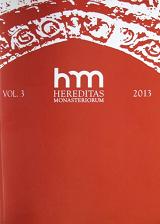Nieznane dwa wizerunki maryjne oraz widok Lwowa z biblioteki klasztoru reformatów przy kościele św. Antoniego Padewskiego w Przemyślu
Two unknown Marian images and an unknown view of Lviv from the library of the Reformed Franciscan monastery at the Church of St. Anthony of Padua
Author(s): Janina DzikSubject(s): Fine Arts / Performing Arts
Published by: Laboratoire de Recherches sur l'Histoire des Congregations et Ordres Religieux (LARHCOR)
Keywords: painting; library; monastery; Reformed Franciscans; Przemyśl (Poland); Marijampolé (Lithuania); Raphael’s Madonna of Loreto; Our Lady of Marijampolé; Lviv (Ukraine)
Summary/Abstract: Research carried out at the Reformed Franciscan monastery in Przemyśl has revealed information about three interesting historical objects recently discovered in the monastery library. Although their provenance is unknown, they may come from dissolved monasteries. They are: two images of the Madonna and Child as well as a view of Lviv. The painting depicting the Madonna with Child which comes from the turn of the 18th century (?) and which is by an unknown author was modelled on a miraculous painting from Marijampolé, dated late 16th century. It was initially owned by Stanisław Jan Jabłonowski (1634-1702), Castellan of Cracow and Grand Crown Hetman, who would take it with him on his military expeditions, which is why it was referred to as the Hetman Madonna, Knightly Madonna or Victorious Madonna. The painting was donated by his son, Jan Stanisław (1669-1731), to the Holy Trinity Church in Marijampolé, a town founded by Stanisław Jan Jabłonowski as votive offering after the victory at Vienna, and placed in the main altar. The origins of the copy kept at the Przemyśl monastery are unknown. It may have been made in connection with an intensification of the cult of its original in the 1730s. The copy of Raphael’s Madonna from S. Maria del Popolo, which were made between the 16th and 20th centuries. Several of the copies are kept in Poland. The view of Lviv, made on parchment around 1640 by an unknown author, was reused as a cover for Simone Maioli’s work, Dies caniculares hoc est colloqvia tria... In the drawing we can see a fragment of a notarial formula ending with a date and place of its entry: “Leopoli, 164(?)”, and a signature of Józef Bartłomiej Zimorowic (1597-1677), town clerk, mayor of Lviv and its chronicler. It is a fragment of a document with a decorative border on the left, which was probably the left edge of the document. Most of the parchment is covered by a gouache-painted (?) view of Lviv from the first half of the 17th century, which is indicated by buildings that can be recognised when the parchment is compared with a copperplate print published in Civitates orbis terrarum (1618). The buildings include the Latin cathedral with its still Gothic cupola, the city hall and what is probably a fragment of the market square. There is also a distinct fragment of city walls. The work is probably the oldest known drawing of the city. ( Madonna di Loreto, Madonna del velo ) comes from the 18 th century; we know neither its author nor its provenance. It faithfully follows the compositional pattern of Raphael’s painting, with the Madonna covering the Child with a thin veil and St. Joseph in the background leaning on a cane. It has been established that the painting from the Przemyśl monastery is a copy of the painting kept at Musée Condé in Chantilly. It is one of the many copies of Raphael’s picture of the Madonna from S. Maria del Popolo , which were made between the 16 th and 20 th centuries. Several of the copies are k
Journal: Hereditas Monasteriorum
- Issue Year: 2013
- Issue No: 3
- Page Range: 219-230
- Page Count: 12
- Language: Polish

